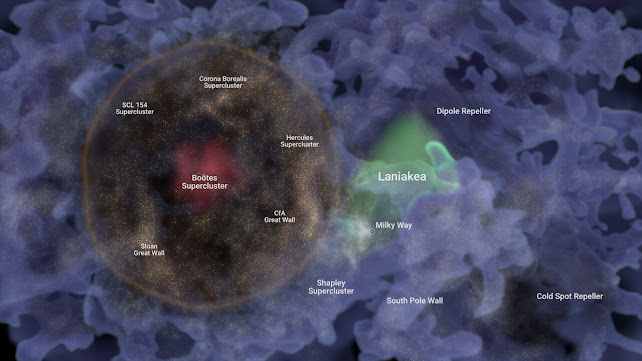
The Sloan Great Wall (SGW) is one of the largest known cosmic structures in the observable universe. It is a massive galaxy filament spanning approximately 1.37 billion light-years in length, making it one of the most extensive and mysterious structures ever discovered. This colossal feature challenges our understanding of large-scale cosmic formations and the distribution of matter in the universe.
Discovered in 2003 by J. Richard Gott III and his colleagues using data from the Sloan Digital Sky Survey (SDSS), the Sloan Great Wall remains a subject of interest in cosmology, astrophysics, and large-scale structure formation studies.
What is the Sloan Great Wall?
The Sloan Great Wall is a filamentary structure composed of numerous galaxy clusters, superclusters, and voids that stretch across vast cosmic distances. Unlike traditional walls or physical barriers, it consists of gravitationally bound galactic structures forming an interconnected web, shaping the cosmic fabric of the universe.
Key Characteristics of the Sloan Great Wall:
Length: ~1.37 billion light-years
Width: Varies but extends over hundreds of millions of light-years
Depth: ~100-200 million light-years
Number of Galaxies: Thousands of galaxies and clusters
Location: Part of the large-scale structure of the universe, found within the SDSS survey region
Components of the Sloan Great Wall
This immense structure is composed of several interconnected superclusters, which include:
1. Coma Supercluster
One of the densest galaxy superclusters, the Coma Supercluster contains thousands of galaxies within 300 million light-years.
2. Leo Supercluster
A massive collection of galaxies within the Sloan Great Wall, contributing to its large-scale connectivity.
3. Hercules Supercluster
Another dense region with gravitationally bound galaxies, helping to define the complex cosmic web structure of SGW.
4. Multiple Void Structures
Between these galaxy superclusters, there exist vast cosmic voids—regions with very few galaxies—creating a striking contrast to the dense walls of the SGW.
How Was the Sloan Great Wall Discovered?
The Sloan Digital Sky Survey (SDSS), an extensive sky-mapping project, helped uncover this massive cosmic structure by analyzing the large-scale distribution of galaxies. The survey collected redshift data from millions of galaxies, allowing astronomers to map their positions in three-dimensional space.
In 2003, J. Richard Gott III and colleagues used this dataset to identify the Sloan Great Wall by recognizing a continuous arrangement of galaxies that spanned over a billion light-years.
Scientific Significance
The discovery of the Sloan Great Wall has profound implications for cosmology and astrophysics. Here are some key reasons why this structure is significant:
1. Challenges the Cosmological Principle
The Cosmological Principle states that the universe should appear uniform and isotropic on sufficiently large scales. However, structures like the Sloan Great Wall suggest that in some cases, matter is distributed in highly non-uniform ways, raising questions about whether the principle holds true at extreme cosmic distances.
2. Understanding Cosmic Web Formation
The Sloan Great Wall provides crucial insights into the large-scale structure formation of the universe. Its existence aligns with the Lambda Cold Dark Matter (ΛCDM) model, which suggests that galaxies form along vast filaments connected by dark matter.
3. Galaxy Evolution and Distribution
Studying the Sloan Great Wall helps astronomers understand how galaxies evolve in dense cosmic environments. Galaxies in large structures tend to have older, redder populations compared to isolated galaxies in voids.
4. Dark Matter and Dark Energy Influence
The formation of such massive cosmic structures requires the gravitational influence of dark matter. Additionally, dark energy, which accelerates cosmic expansion, plays a role in shaping the long-term evolution of these structures.
5. Comparison with Other Large Structures
The Sloan Great Wall is not the only gigantic cosmic formation. It is often compared to other large structures, such as:
The Hercules-Corona Borealis Great Wall (~10 billion light-years long, currently the largest known structure)
The CfA2 Great Wall (~500 million light-years long)
The Laniakea Supercluster (A structure that includes the Milky Way)
Future Research and Observations
Despite its immense size, the Sloan Great Wall is still being studied for finer details about its composition and formation. Ongoing and future deep-sky surveys, such as the Vera C. Rubin Observatory (LSST) and the Euclid Space Telescope, will provide more data on galaxy distribution, dark matter interactions, and the evolution of cosmic walls like SGW.
Further research will also determine whether structures like the Sloan Great Wall continue growing over cosmic time or if their expansion is limited by cosmic acceleration due to dark energy.
Conclusion
The Sloan Great Wall remains one of the most impressive cosmic structures ever discovered. Its sheer size, intricate network of galaxies, and role in shaping our understanding of large-scale cosmic formations make it an essential topic of study in modern cosmology. As astronomical surveys advance, we may uncover even larger and more complex structures that further challenge our understanding of the universe’s evolution and its grand architecture.


Comments
Post a Comment